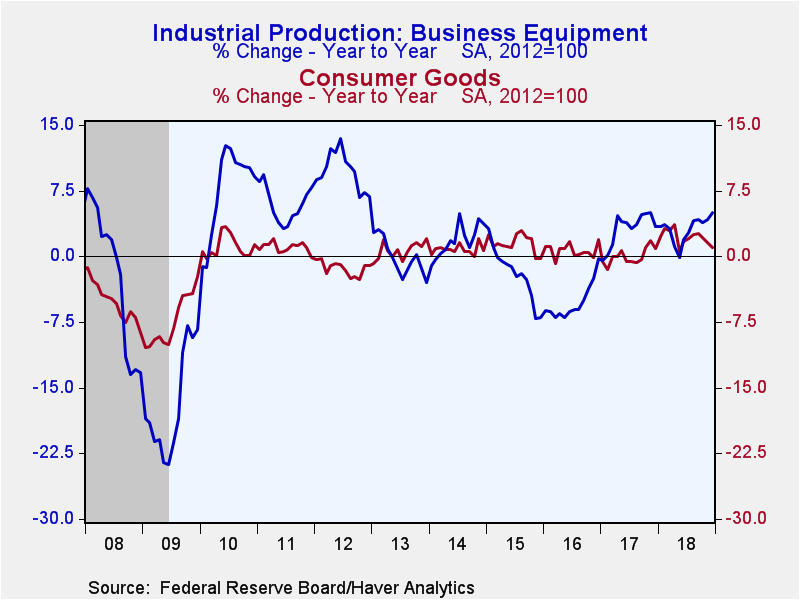 Global| Jan 18 2019
Global| Jan 18 2019U.S. Industrial Production Celebrates 100 Years With An Increase
Summary
In the 100th anniversary of it release, industrial production rose a greater-than-expected 0.3% (3.9% year-on-year) during December following a downwardly revised 0.4% gain in November (was 0.6%). October's output was revised up to [...]
In the 100th anniversary of it release, industrial production rose a greater-than-expected 0.3% (3.9% year-on-year) during December following a downwardly revised 0.4% gain in November (was 0.6%). October's output was revised up to +0.2% from -0.2%. The Action Economics Survey forecast 0.2% growth in December. During the last 100 years, U.S. industrial production has risen 2,094% or an annualized 3.1%.
Manufacturing activity jumped 1.1% (3.3% y/y) during December, with November's reading revised a touch higher. Utilities output fell 6.3% (-4.3% y/y), as a result of unseasonably warm weather in December. US Population-Weighted Heating Days were substantially below normal (89 days). Meanwhile mining activity fired up 1.5% (13.4% y/y).
Manufacturing production was bolstered by both durable goods (1.3%; 5.3% y/y) and nondurables (0.9%; 1.6% y/y). Motor vehicle output accelerated 4.7% (7.8% y/y) and aerospace and computers were up 1.7% (6.2% y/y) and 1.3% (6.5% y/y) respectively. These gains more than offset the 0.6% decline in machinery (+4.9% y/y). In the nondurable sector, chemical production rose 0.5% (3.6% y/y), food grew 0.9% (1.1% y/y), and petroleum & coal sizzled 3.5% (0.7% y/y).
By market group, consumer goods output was unchanged in December (1.0% y/y). Business equipment continued its healthy trend, up 0.5% (5.0% y/y). Construction supplies nailed 1.6% (2.1% y/y) growth. Materials gained 0.5% (6.1% y/y), though energy materials production edged down 0.1 (+9.5% y/y).
In the special aggregate groupings, production of high technology products sparked 1.0% (5.6% y/y). This was the result of strong gains in semiconductor & electronic components (1.5%; 7.5% y/y) and computer & office equipment (0.8%; 1.5 y/y). Factory sector production excluding the motor vehicle and high tech sectors rose 0.7% (2.6% y/y).
Capacity utilization increased to 78.7% in December, above the 78.5% expectations from Action Economics Survey. Factory sector use rebounded to 76.5% close to the business cycle high of 76.6% seen in November 2014. Mining jumped to a cycle high of 94.8%. Growth in capacity in the manufacturing sector continues to accelerate, up a cyclical high 1.4% y/y in December.
Industrial production and capacity data and US Population-Weighted Heating and Cooling Days are included in Haver's USECON database. Additional detail on production and capacity can be found in the IP database. The expectations figures come from the AS1REPNA database.
| Industrial Production (SA, % Change) | Dec | Nov | Oct | Dec Y/Y | 2018 | 2017 | 2016 |
|---|---|---|---|---|---|---|---|
| Total Output | 0.3 | 0.4 | 0.2 | 3.9 | 4.0 | 1.6 | -2.0 |
| Manufacturing | 1.1 | 0.1 | -0.2 | 3.3 | 2.4 | 1.2 | -0.8 |
| Consumer Goods | 0.0 | -0.6 | 0.7 | 1.0 | 2.2 | 0.0 | 0.7 |
| Business Equipment | 0.5 | 0.2 | 0.3 | 5.0 | 3.1 | 3.2 | -5.3 |
| Construction Supplies | 1.6 | 0.2 | -0.4 | 2.1 | 2.8 | 2.5 | 0.9 |
| Materials | 0.5 | 1.1 | -0.1 | 6.1 | 5.9 | 2.0 | -3.0 |
| Utilities | -6.3 | 1.3 | 3.3 | -4.3 | 4.0 | -1.3 | -0.4 |
| Mining | 1.5 | 1.1 | -0.2 | 13.4 | 12.5 | 6.4 | -9.7 |
| Capacity Utilization (%) | 78.7 | 78.6 | 78.4 | 77.3 | 78.0 | 76.1 | 75.4 |
| Manufacturing | 76.5 | 75.8 | 75.9 | 75.2 | 75.7 | 74.8 | 74.6 |
Gerald D. Cohen
AuthorMore in Author Profile »Gerald Cohen provides strategic vision and leadership of the translational economic research and policy initiatives at the Kenan Institute of Private Enterprise.
He has worked in both the public and private sectors focusing on the intersection between financial markets and economic fundamentals. He was a Senior Economist at Haver Analytics from January 2019 to February 2021. During the Obama Administration Gerald was Deputy Assistant Secretary for Macroeconomic Analysis at the U.S. Department of Treasury where he helped formulate and evaluate the impact of policy proposals on the U.S. economy. Prior to Treasury, he co-managed a global macro fund at Ziff Brothers Investments.
Gerald holds a bachelor’s of science from the Massachusetts Institute of Technology and a Ph.D. in Economics from Harvard University and is a contributing author to 30-Second Money as well as a co-author of Political Cycles and the Macroeconomy.









